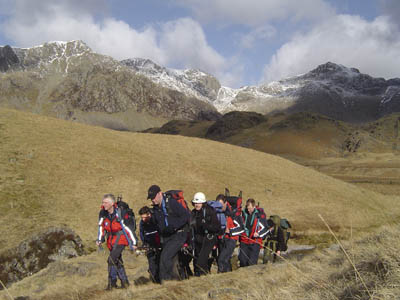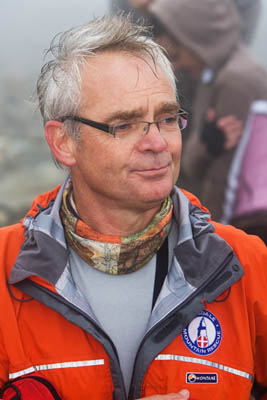
Lake District mountain rescuers at work
Volunteer rescuers in the Lake District are finding it increasingly hard to meet their commitments as the number of callouts rises.
Neighbouring teams often have to be called to help rescuers in busy areas who face having to mount operations two or three times a day at peak times. A public awareness campaign run by teams in the area has had little effect, with a nine per cent rise in incidents last year.
The annual report of the Lake District Search and Mountain Rescue Association – the umbrella body for Cumbrian rescue teams – details 464 incidents for the dozen mountain rescue teams in the area, up 39 on the previous year. Six years ago, the volunteer teams were dealing with only 337 such incidents.
The number of people dying on the fells also showed a worrying increase, up from 13 in 2007 to 19, with fellwalking being by far the most hazardous pursuit, although of course, it is also the most popular so the figures reflect the number of people taking part in the activity. There was also an increase in injuries classed as serious, resulting in a hospital stay of more than 24 hours.
LDSMRA chairman Richard Warren says in the report: “It is difficult to put a finger on why it is happening but there does appear to be an increase in the public’s interest in the challenge of the great outdoors.” The significant increase in workload for the rescuers is, he says, “putting a severe strain on our team members and their ability to make the necessary commitment and sacrifice, turning out for rescue after rescue.”
Some pre-emptive action has had an effect, he says. The recent poster campaign by the Langdale-Ambleside team advising walkers to stay off the winter tops unless properly equipped appears to have both reduced the high number of fatalities at the start of 2009 and increased the numbers of walkers taking advice in purchasing winter equipment in local shops.
However, team members spent a total of 23,000 hours on rescue incidents during 2008. While the number of ‘lost’ walkers declined, there were more ‘benighted’ fellwalkers – 49 altogether – which suggests the message about carrying torches and not undertaking long routes in winter isn’t getting through to some who venture on to the mountains.
While the Original Mountain Marathon provided many column inches of copy and hyperbolic broadcast material, the association points out that many others were in need of mountain rescue that weekend, with floods proving the main hazard. The teams are now fully trained and equipped in water rescue. Mr Warren says: “The ability of the teams to carry out very challenging technical water rescues over that weekend and indeed throughout the year is a credit to the voluntary team member’s willingness to extend their core skills beyond that of mountaineering and mountain rescue, to water rescue.
“Teams are now fully recognised and accepted by both the police and the fire-and-rescue service as being able to provide a full swift water and flood water rescue capability. The investment in equipment and training has been demonstrated to be worthwhile.”
The report also highlights the essential need to carry on the fundraising that each team undertakes, with typical running costs of between £30,000 and £75,000 for each team.

Richard Warren, chairman of the LDSMRA
Mr Warren says: “Donations, bequests and legacies, which are sent into the association, do make a significant difference and it is gratifying to see that the work of the teams is recognised by both those we rescue and the general public who hear about the work we do.
“Income is shared amongst the 12 teams to supplement their own fundraising activities and it is important that those who donate know and understand that their contributions, however small, do make a difference to the ability of teams to provide our free rescue service to the Cumbrian communities and to those visitors who come into the county.”
The volunteer teams, including Sarda dogs, were also aided by search-and-rescue aircraft on 118 occasions, most of which will have been the Sea Kings of the RAF and Royal Navy, with help too from the Great North and North West Air Ambulances.
Mobile phones, say the rescue teams have undoubtedly saved lives. The sooner teams get to an incident, the better the chances of recovery for victims. However, they are also a bane to mountain rescuers when not used properly.
Advice to fellwalkers is to use a mobile phone to call rescuers:
- If you or a member of your party sustains an injury warranting the assistance of a mountain rescue team
- If you come across someone who has sustained an injury warranting the assistance of a mountain rescue team
- If one of the party has become separated from you and you have made every effort to but have been unable to meet up again
- If you want to report having seen or heard any internationally recognised distress calls
- If you wish to notify someone of a change of plan (not a 999 call).
However, it important, say rescuers, not to use the mobile phone at the ‘first sign of trouble’; walkers should be self-reliant if possible. They also warn not to rely solely on the mobile phone as a safety device; there are areas of poor or no reception. The mobile phone is not a substitute for experience, they say.
Richard Warren
14 April 2009Dear Bob (editor) - thank you for the above article which accurately reflects the lakes's position - one point though; the last bullet in the article might suggest that we welcome being informed when a plan changes. The only way you can contact mountain rescue teams is either '999' for an emergency via the Police or via their team websites (non emergency). Bases are unmanned and are only contactable during a rescue and only then when the informant is given the base number to call in on. If groups or individuals do change their plans on a walk or climb and wish to inform someone of the change, they should not contact MR. However, they should make contact with the person who they have left route details with. This is the person that would raise the alarm in the event of a group becoming long overdue and is the person who the team leader will speak to to gather information on where they are parked, what route they were planning, any medical problems, what experience and particularly important, what equipment (torch map & compass plus waterproofs)
Hope this helps
regards
Richard Warren
Chairman LDSAMRA